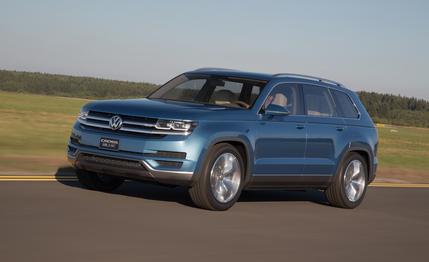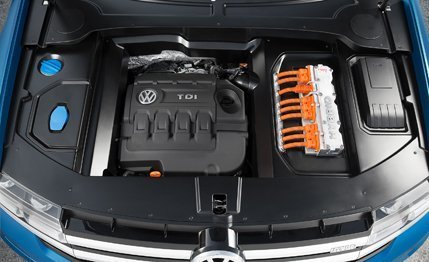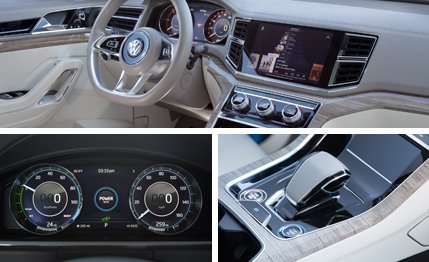 Prototype Drive
Prototype Drive
It’s easy to convince yourself that the American market plays second fiddle to Europe in the eyes of Volkswagen. Compared with their European counterparts, our current Jetta was decontented at launch, and the forthcoming 2015 GTI will be slightly down on power, to say nothing of the fact that we don’t even have the chance to buy stuff like the GTD and Scirocco (for now, anyway). But then consider that we get an excellent America-focused Passat, and we’ll soon see a U.S.-centric mid-size, three-row SUV based on the CrossBlue concept you see here. So VW does care about Americans—in volume segments, anyway. U.S.A.! U.S.A.!
Hanging Out
We recently had the chance to drive the CrossBlue in Germany, but as the concept is fitted with velocity-limiting wheels and tires—plus weather relocated our drive to an aircraft hangar—we couldn’t take it much above running speeds. More important than gathering real driving impressions from an expensive, one-off show property is what that expensive, one-off show property means for the version you’ll be able to buy.

For starters, the CrossBlue makes use of the VW Group’s MQB modular architecture, and that won’t change for production. When the concept debuted, we were told MQB couldn’t scale up properly to handle the load requirements. VW has apparently sorted that out in the meantime, and the final product will be the largest vehicle that can use the bones. They’ll help ensure economies of scale with other MQB products, and the architecture is engineered with saving weight in mind. Dimensionally, the CrossBlue checks in at 196.3 inches in length, 79.3 inches wide, and 68.2 inches tall, although VW says height will rise by at least two inches in the conversion to salable product.
Powertrain Now, Powertrain Future
The CrossBlue’s powertrain is a diesel-hybrid setup that teams the latest EA288 2.0-liter turbo-diesel four, a six-speed DSG dual-clutch automatic, and two electric motors—one at each axle. The diesel produces 190 horsepower and 280 lb-ft of torque on its own, the front-mounted electric motor makes 54 horses and 133 lb-ft, and the rear-mounted unit (borrowed from the e-Golf) is good for 114 and 199. Total system output stands at 305 horsepower and a prodigious 516 lb-ft of twist. Volkswagen says the CrossBlue has a theoretical top speed of 127 mph and could sprint from 0 to 60 mph in 7.0 seconds.
There are a six drive modes, selected via a drive-mode selector knob or a row of drive-mode buttons. The CrossBlue’s normal mode of operation is Hybrid, in which the TDI drives the front wheels and the rear-mounted electric motor powers the rears. Within the Hybrid setting, Sport and Eco submodes are offered via the drive-mode selector; it lives next to the angular gear shifter that will become the unit of choice in all future DSG-equipped VWs.

EV, Off-Road, and Charging programs are toggled using buttons that reside at the bottom of the center stack. In EV mode, propulsion is handled solely by the rear-mounted electric motor. Off-Road mode provides permanent all-wheel drive, regardless of the 9.8-kWh lithium-ion battery’s state of charge. This is enabled by the fact that the diesel engine feeds power to the front electric motor, which in turn acts as a generator to deliver electrons to the rear motor. Charging mode ramps up energy recuperation and is the mode a driver might select as he or she approaches low- or zero-emission zones in city centers. The transition between these modes is imperceptible except for the muffled clatter when the turbo-diesel relights. The CrossBlue can travel up to 14 miles and to a maximum of 75 mph on electrons alone, and total range is claimed to be 661 miles. Volkswagen says the show car would be good for EPA ratings of 33 mpg city and 37 highway and 89 MPGe.